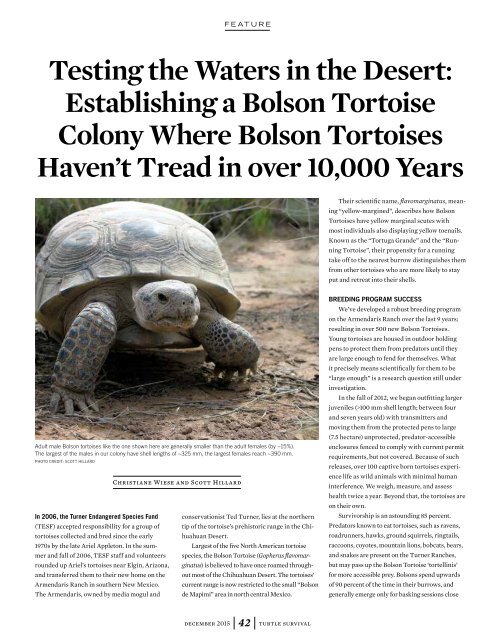Turtle Survival
2tUaeTbNi
2tUaeTbNi
Create successful ePaper yourself
Turn your PDF publications into a flip-book with our unique Google optimized e-Paper software.
FE ATURE<br />
Testing the Waters in the Desert:<br />
Establishing a Bolson Tortoise<br />
Colony Where Bolson Tortoises<br />
Haven’t Tread in over 10,000 Years<br />
Their scientific name, flavomarginatus, meaning<br />
“yellow-margined”, describes how Bolson<br />
Tortoises have yellow marginal scutes with<br />
most individuals also displaying yellow toenails.<br />
Known as the “Tortuga Grande” and the “Running<br />
Tortoise”, their propensity for a running<br />
take off to the nearest burrow distinguishes them<br />
from other tortoises who are more likely to stay<br />
put and retreat into their shells.<br />
Adult male Bolson tortoises like the one shown here are generally smaller than the adult females (by ~15%).<br />
The largest of the males in our colony have shell lengths of ~325 mm, the largest females reach ~390 mm.<br />
PHOTO CREDIT: SCOTT HILLARD<br />
In 2006, the Turner Endangered Species Fund<br />
(TESF) accepted responsibility for a group of<br />
tortoises collected and bred since the early<br />
1970s by the late Ariel Appleton. In the summer<br />
and fall of 2006, TESF staff and volunteers<br />
rounded up Ariel’s tortoises near Elgin, Arizona,<br />
and transferred them to their new home on the<br />
Armendaris Ranch in southern New Mexico.<br />
The Armendaris, owned by media mogul and<br />
Christiane Wiese and Scott Hillard<br />
conservationist Ted Turner, lies at the northern<br />
tip of the tortoise’s prehistoric range in the Chihuahuan<br />
Desert.<br />
Largest of the five North American tortoise<br />
species, the Bolson Tortoise (Gopherus flavomarginatus)<br />
is believed to have once roamed throughout<br />
most of the Chihuahuan Desert. The tortoises’<br />
current range is now restricted to the small “Bolson<br />
de Mapimi” area in north central Mexico.<br />
BREEDING PROGRAM SUCCESS<br />
We’ve developed a robust breeding program<br />
on the Armendaris Ranch over the last 9 years;<br />
resulting in over 500 new Bolson Tortoises.<br />
Young tortoises are housed in outdoor holding<br />
pens to protect them from predators until they<br />
are large enough to fend for themselves. What<br />
it precisely means scientifically for them to be<br />
“large enough” is a research question still under<br />
investigation.<br />
In the fall of 2012, we began outfitting larger<br />
juveniles (>100 mm shell length; between four<br />
and seven years old) with transmitters and<br />
moving them from the protected pens to large<br />
(7.5 hectare) unprotected, predator-accessible<br />
enclosures fenced to comply with current permit<br />
requirements, but not covered. Because of such<br />
releases, over 100 captive born tortoises experience<br />
life as wild animals with minimal human<br />
interference. We weigh, measure, and assess<br />
health twice a year. Beyond that, the tortoises are<br />
on their own.<br />
Survivorship is an astounding 85 percent.<br />
Predators known to eat tortoises, such as ravens,<br />
roadrunners, hawks, ground squirrels, ringtails,<br />
raccoons, coyotes, mountain lions, bobcats, bears,<br />
and snakes are present on the Turner Ranches,<br />
but may pass up the Bolson Tortoise ‘tortellinis’<br />
for more accessible prey. Bolsons spend upwards<br />
of 90 percent of the time in their burrows, and<br />
generally emerge only for basking sessions close<br />
december 2015 42 turtle survival


